OREGON (Day 3 - part 1)
We grabbed some breakfast at a cute place called Big City, then hit the road, continuing northeast into Oregon.

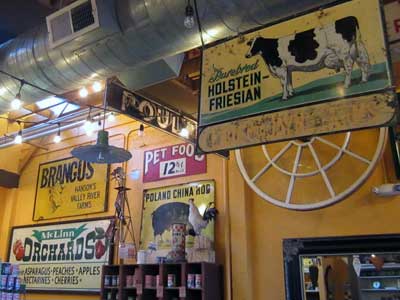




The Oregon Territory was created in 1848, and Oregon became a state in 1859.
We stopped briefly to stretch our legs in the town of Vale.


This area was originally popular with fur trappers. In 1828, Peter Skene Ogden passed through here (remember him from the mural in the Utah capitol building). Early travelers along the Oregon Trail chose to cross the Malheur River here because of nearby hot springs where they could rest, bathe and wash their clothes. This was the common route west until the first transcontinental railroad was completed in 1869.
The Oregon Trail spanned 2,170 miles, from the Missouri River to the valleys in Oregon. Originally, it was only passable on foot or by horseback. The first wagon train came through in 1836. Each year, improvements were made in the form of bridges, cutoffs, ferries and roads. Today's highways, such as Interstates 80 and 84, follow parts of the old trail and pass through the old towns (such as Vale).

Eventually, about 16 different pioneer trails crossed through Oregon.


(left) An information booth contained lots of stories and history.

The Malheur River here had a spring that was so hot it was said one could even cook a fish in it! (note the guy dipping a fish in the background).
Malheur comes from the French words mal (bad) and heur (hour). It's based on a story from beaver trappers back in 1814. They were so successful that they couldn't carry all the fur back on one trip, but while they were away, local tribes discovered and took all the rest.
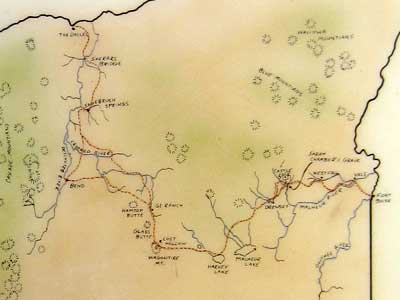

The Meek Cutoff (click for a larger view) ... and the Blue Bucket gold
Stephen Hall Meek (1807 - 1889) was a fur trapper and explorer. In 1845, he convinced some 1,000 people in 200 wagons to attempt a shortcut around the Blue Mountains, which is now known as the Meek Cutoff. So here at Vale, they turned off the primary Oregon Trail and followed Meek into the desert, where no wagons had traveled before. The travel was so difficult that several oxen died each day. It was also a drought, so most of the lakes had dried up. By Lost Hollow, both water and food had become scarce. People started to get weak and sick. Scouts were sent out in all directions for many miles looking for water but all came back empty-handed. At this point, the emigrants mutinied and headed northwest. Meek, fearing for his safety, went on ahead and was able to send help back to the travelers. It took nearly two weeks for the rescue party to get the entire wagon train across the Deschutes River. At least 23 had died along the way and another 25 died of exhaustion and starvation upon reaching The Dalles.
During the search for water. W.J. Herren and his sister took their old blue wooden buckets and followed a dry creek to a seepage. There they supposedly found some gold. The search for Blue Bucket gold caused prospectors to flood into the area... and while other precious metals were found there, the gold remained elusive.
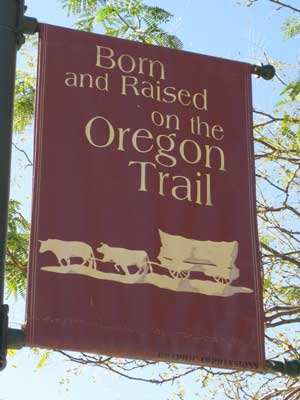
The town of Vale stands today on the same site where many emigrants camped. It literally was born and raised on the trail.




It was right here, near some hot springs, that the first structure (a temporary trading house) was built sometime before 1853. Eventually the location was bought by Lewis B. Rinehart who built the Stone House, which opened as a hotel in 1873. In 1883, it leased for the first post office and Vale became the official name of the Malheur Crossing.
“Born and raised on the Oregon Trail ” was depicted on over 30 murals throughout the town that showed the history of the area. These were started in 1992, with new ones being added each year. We only scratched the surface with three of them.

"The Escort", painted in 1996 by Don Prechtel and R.E. Pierce, shows a silver shipment being escorted by the cavalry down an early military road.
As settlers moved west, the US military built outposts to provide protection. When mining flourished, the army also provided escorts for precious ore shipments and payrolls.




"Journaling", painted in 1995 by Dorthy Danielson, shows a mother reading to her child while the man writes in his journal along the banks of the Malheur River. After walking 10 to fifteen 15 per day for almost six months, most pioneers had limited time and energy, yet many still made reading and writing a priority.
"Our camp this night was on the Malheur Creek, a stream about two rods wide at the crossing. Here we found a rock bottom, with springs of hot water boiling up in the bottom of the ford. At this place, there is a large butte of red lava that looks like it had not got cool yet, and one would hardly suppose it had, from the number of hot springs along its base. The grass is here very good, but the water is rather warm."

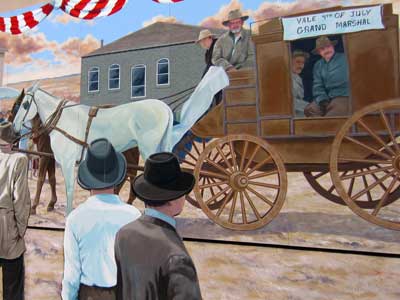
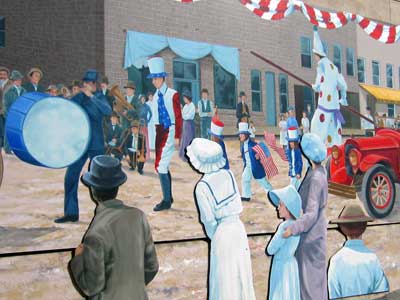
“Patriots on Parade”, painted by Colleen Mitchell-Vena, shows a 4th of July parade on Main Street in the early 1900s.


What was fascinating about this mural was that it was three-dimensional. Several of the figures in the foreground were wooden cutouts then attached to the wall. They literally popped out of the scene.


We left Vale and continued west along US Route 20.


There were numerous trucks filled with onions!
return • continue

